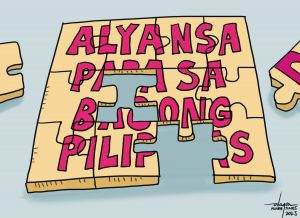Last year, as in the past many years, we seldom missed writing a column every day. That is, that over the years we wrote this Rough Cuts column treating issues ranging from politics, environment, socio-cultural, economics, and even those on family relations.
In this column today we are retracing the top three issues we most wrote about during the last 12 months of the preceding year.
Issue No. 1:
We seem to be like a broken record writing about the well-veiled white elephant hidden in some government infrastructure projects that, at first glance, seem extremely important for the masses. We are referring to the inclusion of two elevator units in some of the city’s overpass projects, specifically the ones in Calinan and Mintal districts’ central areas. We are not certain if the overpasses in Toril, Tibungco and others have the same provision for people’s lifts.
We had been harping about this issue because since the completion of the overpasses some two years ago or over, the elevators have never been put to public use. Now, the deterioration of the lifting equipment is already clearly visible. The metal housing boxes of the elevator’s control systems in the Calinan overpass are already rusting. For what will not surrender to the wickedness of the non-sleeping rust when the boxes are exposed to natural elements?
Sadly, with the many times we tackled the issue in this column, we never had gotten even a single reaction from the government agencies believed to be the ones on top of the project implementation. And mind you, if we have to believe the project cost provided in the billboard installed in the project location, each overpass with elevators is a little over P16 million. And most likely the two lift equipment could be close to 50 percent of the total project cost.
Now, if that is not a waste of people’s money then what could the inclusion of those elevators be?
Issue No. 2:
The issue that we believe we have also written mostly about is the one on the non-compliance of contractors of government infrastructure projects to install billboards in strategic locations within the vicinity of the project site containing relevant information as part of the so-called transparency program (or should it be the miserable failure of government agencies to compel contractors to comply for reasons only a few people know?).
We have made it a habit to check the vicinity of government infrastructure project sites we happened to pass by either purposely or accidentally. And we have observed that there is hardly any full compliance of such requirements.
Yes, there may be billboards installed. However, most of these do not contain the information the public wanted to know. Always, the most prominent information provided is the name of the contractor. Then the total project cost. But more often than not the date of completion is not shown and the space for such information is left blank. We surmise that both the contractor and the government agency that has the province in the project implementation are afraid that the people could already assume the number of days, months, or perhaps even years of its slippage.
Issue No. 3:
The third issue that we most wrote about in the whole of 2019 is on the burgeoning traffic problem of Davao City.
We have no doubt that as early as 10 years ago the growth of the city’s economy was already in its fastest pace. Notwithstanding the disruption created by the conversion of some parts of the city into an urban insurgency laboratory in the 1980s and in the early 90s this southern metropolis growth was by leaps and bounce.
Major economic activities surged in Davao City with the location of several industries and giant retail businesses. As a consequence, people looking for job opportunities came rushing. So, in the second half of the 90s up to the present Davao’;s economy was not just in boom but in bloom as well. With people finding jobs here and having more disposable income it is not surprising that many invested in public transportation businesses. Many well-paid workers ventured into buying their own cars for their private use. What with transport dealers aggressively undertaking marketing strategies that suit the new rich of the city.
Unfortunately for both the national and local governments, planning for projects to arrest the growing traffic problem was seemingly wanting. If at all there were certain projects as additional roads to and from the city proper, as well as bridges, it took a millennium to get its approval, and another long years waiting for the project to be implemented. Classic example is the Phase 1 of the Mindanao Railway System that got the boost with the election of former Mayor Rodrigo Duterte as President of the Philippines. Four years into PDigong’s term and not even a single rail is put in place.
So, instead of being a few steps ahead of the evolution of the traffic problem both local and national governments are already breathing heavily doing some catching up.
This year though, we are optimistic that there might already be some changes in the attitude of government officials in dealing with potential problems. We are hopeful as well, that they would not allow certain situations to evolve into a gargantuan problem before taking steps to arrest the same.


